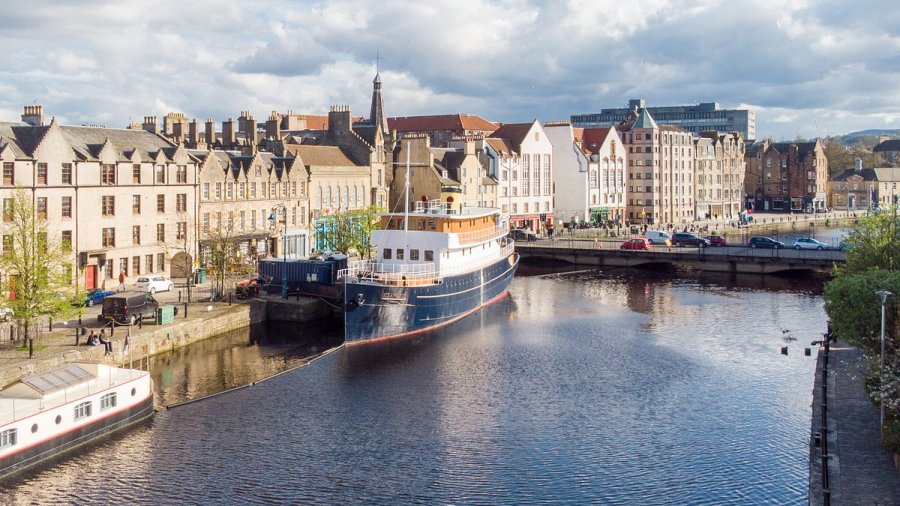Scotland has seven cities – and five are on the coast. SIMON BALDWIN takes a tour of the best Scottish coastal city breaks with recommendations on what to see, unique places to stay and where to enjoy some of the finest food and drink.
Miles of words have been written about the North Coast 500, so we’re steering clear on this occasion and focusing on Inverness and the immediate coastline that can be enjoyed on a break.
The city divides two firths – Beauly and Moray. On the western side, why not cycle the Beauly Firth Loop, an exploration of stunning landscapes, historic villages and wildlife that skirts the coastline on a 26-mile ride? You’ll enjoy views of the sea and mountains as well as heritage sites, including the 17th century Wardlaw Mausoleum that starred in the film Outlander.
Bring your walking boots and explore the Highland capital with trails and paths that take you in and around the city – along the River Ness, canal locks and shoreline. For the more adventurous, you can make Inverness your starting point to take on the 146-mile John O’ Groats Trail.
Where to stay? The city has a wealth of hotels and guest houses. Looking for something different? Try the Ghillies Lodge on the banks of the Ness in the city. It sleeps up to six and is pet-friendly.
On the tidal Ness you’ll find one of the best places to enjoy local fayre: the Mustard Seed Restaurant. Created in a former church building, it has kept many of the original features. Best of all, they’ve added a top floor terrace with great river views for dining alfresco – and to enjoy a cocktail or two.
They have lunch, early evening and dinner menus – cater for kids – and also have a great whisky ‘scatter graph’ that lays out their collection showing light versus rich and delicate versus smoky: a great introduction to those trying malts for the first time.
Across to Scotland’s north east coast and the Granite City of Aberdeen that has grown up over centuries around the mouth of the River Don. In fact, the city’s very name translates as ‘Mouth of the River Don’ with records dating back to 1180.
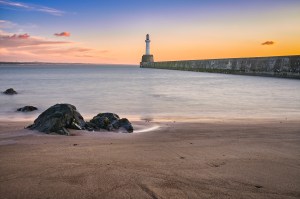
Explore the lesser known gems of Scotland.
Wherever you walk, there’s no escaping the granite. So fine was the stone from the now defunct Rubislaw Quarry that around six million tonnes of it were used to help build not only Aberdeen’s finest buildings but also London’s Waterloo Bridge and the Palace of Westminster’s River terrace.
Softening the granite landscape is an incredible array of parks and gardens – more than 40 in total – where millions of daffodils, crocuses and roses provide a breath-taking splash of colour and has seen Aberdeen win the Royal Horticultural Society’s Britain in Bloom Best City title on ten occasions.
Where to stay? Be…enlightened! Book in advance to secure your accommodation in one of the city’s most historic landmarks, the Girdle Ness Lighthouse, just on the south side of the entrance to Aberdeen’s harbour. The Northern Lights Apartments let properties on the site including what was the Principal Lighthouse Keeper’s home. Dating from 1833, it is a three-bedroomed cottage inside the lighthouse’s walled compound.
Where to eat? The city has a wealth of great cafes, bistros and restaurants catering for all budgets and tastes. As we’re suggesting a self-catered stay, take time to discover Herd’s The Butcher. Combined with their farm shop and delicatessen, they’ve been trading on the same site in Aberdeen’s Rosemount Place since 1947. If they don’t farm the produce themselves, they are exacting in choosing from others. Shelves stacked with groceries as well as their own baker.
Head into Angus – you can detour off the dual to discover some truly spectacular coastline including the must-visit Dunnottar Castle – and you’ll arrive in Dundee on the River Tay.
Famed for “the three Js” – Jute, Jam and Journalism – the city’s wealth and influence grew on all three. Just over a century ago, Dundee’s Jute mills and their related businesses employed the vast majority of Dundonians. Jam – or more precisely marmalade – was ‘invented’ in Dundee in 1797. Worldwide exports of the breakfast spread and jams aplenty were shipped from the city’s docks.
Journalism? Dundee is home to DC Thomson, one of the largest media companies in the UK and, famously, publisher of The Beano and The Dandy.
Today, the city is rebranding itself. The jute mills are gone – but not forgotten. A burgeoning cultural and heritage industry is growing, showcasing the city’s industrial past whilst, at the same time, nailing its colours to the mast of new opportunities.
Two of the world’s most famous wooden ships can be found on the revitalised waterfront – the RRS Discovery on which Captain Scott sailed to Antarctica as well as the 46-gun warship HM Frigate Unicorn, the oldest British-built ship still afloat that has just secured funding for its long-term preservation.
Between them is the V&A – the first design museum in Scotland and the first Victoria and Albert Museum outside London – and in the downstream plan will be the Eden Project Dundee, “a landmark development for the city, transforming the former gasworks on East Dock Street into a beacon for regeneration and green tourism”.
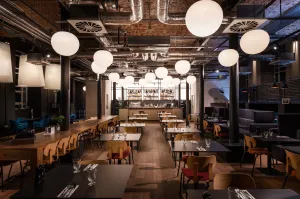 Where to stay – and eat? We’re combining them in Dundee. Two of the grandest of the Jute Mills were built 200 years ago by the Baxter family overlooking the city’s waterfront. The Jute trade dried up and, eventually, the buildings were abandoned. They were grade-A listed to reflect their importance in the city’s past and, in 2018, were bought and converted. Today, they are the 102-bedroom boutique Hotel Indigo, the award-winning Daisy Tasker Restaurant – together with an 85-suite aparthotel, all just a ten-minute walk from the V&A.
Where to stay – and eat? We’re combining them in Dundee. Two of the grandest of the Jute Mills were built 200 years ago by the Baxter family overlooking the city’s waterfront. The Jute trade dried up and, eventually, the buildings were abandoned. They were grade-A listed to reflect their importance in the city’s past and, in 2018, were bought and converted. Today, they are the 102-bedroom boutique Hotel Indigo, the award-winning Daisy Tasker Restaurant – together with an 85-suite aparthotel, all just a ten-minute walk from the V&A.
In the suites, Dundee’s history and culture abound with décor that incorporates the city’s ‘jam, jute and journalism’ badge. As a guest, you have complimentary breakfast, access to the 24/7 fitness suite as well as on-site laundry facilities – and each room has its own kitchenette and living area.
The restaurant is named as a tribute to a young mill worker, Daisy Tasker, who – aged just 14 – used to organise tea dances and dinners out for her fellow workers. Her spirit for socialising lives on – reflected by the hotel’s young team of chefs who revel in highlighting the finest local Scottish ingredients.
Two cities remain – and we’re heading west to Glasgow to take to the water – in 1946. That’s when the very last of the paddle steamers built on the River Clyde was launched: the Waverley. The following summer, she began her many years of service, cruising Lochs Long and Goil.
Approaching 70 years on, the Waverley is still paddling…and still visiting villages along that same route – but there have been choppy waters along the way. Some 50 years ago, her operator sold her for a pound. Twenty years ago, she underwent a £7m heritage rebuild and just before lockdown another appeal raised more than £2m to replace her boiler.
Today, you can climb aboard the world’s last seagoing paddle steamer in Glasgow at the city’s Science Centre – and experience the unique magical sights and sounds of steamship travel. Timetables change with the seasons. The latest trips included Clyde river cruises, excursions to see the Isle of Bute’s coast, visits to Tighnabruaich on the Cowal Peninsular and, of course, a cruise along Loch Long where she started her illustrious career all those years ago.
There’s a wealth of leading hotels along the Clyde through Glasgow but in keeping with the Waverley, we’d like to recommend something a little different: a houseboat. Gerda of Glasgow is a stunning narrowboat moored next to Speirs Wharf, just a ten-minute walk from the city centre. Gerda sleeps four across two bedrooms and has two bathrooms. There’s also wi-fi and free parking.
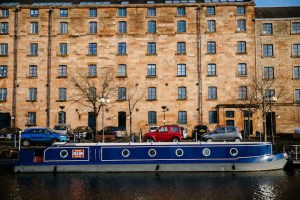
So where to eat? There are more than 1,500 eateries across the city so you’re not short for choice. Close to Gerda is the highly rated Ocho at Spiers Wharf – great for breakfast, brunch and lunch where every dish is homemade using ingredients that are delivered daily by their local suppliers.
Our final coastal city is Scotland’s capital, Edinburgh. The completion of a long-awaited tram service that now connects the airport through the city centre to Leith makes the city’s coast more accessible than ever. We are focusing on The Shore – the picturesque area at the heart of Leith.
That was not always the case: 50 years ago, much of the former docks and harbour were earmarked for demolition. Thankfully, time and tide did wait. The Shore and areas around it have been transformed, making it one of the most desirable destinations in the city.
Significant investment in waterfront living and improvements to the harbour – plus the siting of the Royal Yacht Britannia after she was decommissioned in 1997 – coincided with the arrival of gastronomes. Leith boasts some of the best eateries in Scotland – including two Michelin-starred eateries, The Kitchin and Restaurant Martin Wishart. You won’t go wrong with either. However, there are plenty of choices in Leith to suit all budgets and tastes – and many more in the city centre, just a short tram ride away.
Where to stay? We’re going to continue with the ‘life on board’ theme and recommend a night in the Ocean Mist that is moored on the Shore. The 17-bedroom boat – with a choice of state room, cabins or berths – has had an amazing history since it was built as a minesweeper in 1919. Owned by racing drivers, playboys, politicians and businessmen, she saw service in the Second World War and was torpedoed.
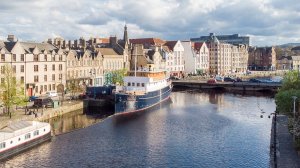
In more recent times, the boat has been a floating restaurant and nightclub before being acquired by its current owner in 2018. Today, she is restored to her former glory as a boutique hotel, steeped in 1920s elegance and with all the comforts you’d expect from 21st century accommodation.
Whichever coast, Scotland’s cities offer a choice of fantastic weekend break destinations where you can travel through nature, time and a mouth-watering array of culinary journeys. Slainte!

